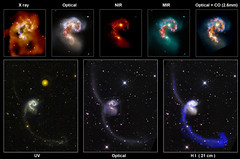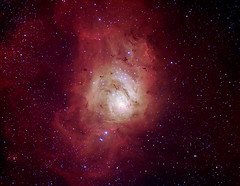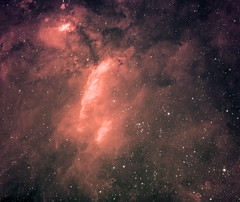Yesterday I explained we are resuming the scientific observations at Siding Spring Observatory (NSW, Australia) since the recent bushfires on 13 January 2013. Today we have used this telescope to observe the Near Earth Asteroid (NEA) 2012 DA14, which is getting its closest encounter to our planet today (it will be at only 27000 km from the surface of the Earth). Here you have the details:
The path of the NEA 2012 DA14 from the AAT. Observed during the evening twilight on the 15 February 2013 using the FPI camera of the 2dF instrument at the 3.9m Anglo-Australian Telescope located at Siding Spring Observatory (NSW, Australia). 25 frames, 2 seconds exposure each, 5 seconds between frames. First frame obtained at 09:53:54 UT, last one at 09:56:22.
Support Astronomers: Lee Spitler (MQ/AAO) & Andy Green (AAO).
Night Assistant at the AAT: Steve Chapman (AAO).
Edition of the data and movie: Ángel R. López-Sánchez (AAO/MQ).
Link to the video in my Flick.
The data were obtained by Lee Spitler (MQ/AAO), Andy Green (AAO) and Steve Chapman (AAO) during the evening twilight while waiting the sky was dark enough to start the scheduled scientific observations. We will try to get more data of this object during the morning twilight. More to come soon!
Update at 14:45 AEST, 16th Feb 2013
I’ve checked there are some problems to watch the video using smartphones and tablets such iPhones and iPad. Just try this link and it should work, although you may get a low resolution version of it. I’m creating a new video to be uploaded to YouTube. At the same time, I’ve just finished this image showing a mosaic with 13 of the frames obtained for the video.

Mosaic with the path of the NEA 2012 DA14 from the AAT. Observed during the evening twilight on the 15 February 2013 using the FPI camera of the 2dF instrument at the 3.9m Anglo-Australian Telescope located at Siding Spring Observatory (NSW, Australia). Each frame has an exposition time of 2 seconds.Times are shown in Universal Time (UT), add +11 hours to get the local time in NSW.
Support Astronomers: Lee Spitler (MQ/AAO) & Andy Green (AAO).
Night Assistant at the AAT: Steve Chapman (AAO).
Edition of the data and movie: Ángel R. López-Sánchez (AAO/MQ).
Finally, I confirm we also observed the NEA at the AAT during the morning twilight.
Update at 16:55 AEST, 18th Feb 2013
An updated version of the video, which is now in HD and includes the celestial coordinates, has been included in this excellent article published today in The Conversation by Simon O’Toole (AAO).
The path of the NEA 2012 DA14 from the AAT. Observed during the evening twilight on the 15 February 2013 using the FPI camera of the 2dF instrument at the 3.9m Anglo-Australian Telescope located at Siding Spring Observatory (NSW, Australia). 25 frames, 2 seconds exposure each, 5 seconds between frames. First frame obtained at 09:53:54 UT, last one at 09:56:22.
Support Astronomers: Lee Spitler (MQ/AAO) & Andy Green (AAO).
Night Assistant at the AAT: Steve Chapman (AAO).
Edition of the data and movie: Ángel R. López-Sánchez (AAO/MQ).








Hi Angel, I enjoy your blog! I was wondering about the name, however. I think the English translation for “El Lobo Rayado” might be “The Striped Wolf” rather than “The Lined Wolf”. But since I don’t know Spanish – or wolves – I’m not sure! Cheers, Matthew Colless.
Hi Matthew, thanks a lot for your words and comment, the very first one I got here!
Actually, as it happened when I was searching for a name for my Spanish blog 10 years ago, the “decision of the name of the blog” was not an easy point. After trying many options related to Wolf-Rayet stars I had two top titles: “The Lined Wolf” and indeed “The Striped Wolf”. Both “Lined” and “Striped” seem to mean (at least for me) similar in this context… so at the end I chose “Lined” because of the connection with “Emission/Absorption Lines”, which at the end was also the final meaning of “Rayas” (Líneas, Lines) for my Spanish blog.
However, if from my native English speakers colleagues I’m suggested to change the title, I still can do it as I’m just starting with this blog!
Hi Angel – I think that the way you come up with the name is great! Really clever. It’s also a great blog!
Simon
Thank you very much Simon! Now that it is public, I should try to update it more often. Ah, I tried to include your blog in the list of the left column, which I created long time ago, but it doesn’t work, no idea why… Although I’m pretty familiar with blogs, I’m used to have “the control of everything” using html, but that is not the case of WordPress.
I think the connection with the absorption lines is a perfect excuse for the author’s license (and a bit nerd too 🙂 I suggest you to add a link to an official explanation always visible.
I did not know this one in English!! Where do you get the time?
Good work!
Thank you, Fernando. More than absorption lines, the connection is with emission lines: the broad features of Wolf-Rayet stars are in emission, and studying star-formation galaxies the main information is coming from the emission lines of the ionized gas. I explained all of that in my “Spanish blog” when I created it and I also intended to tell it here. It’s just I was waiting to have a few posts here regarding my research before opening it public to everyone. But because of the circumstances I decided to do it now.
Don’t worry, I’ll dedicate a post to that and link it from the home page, although something is already explained in tab “About”.
This blog is a great idea. I will be happy to read you in English too. 🙂
Thank you very much, Mizar!